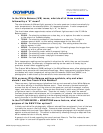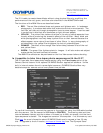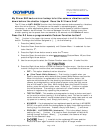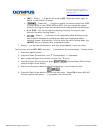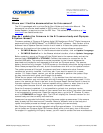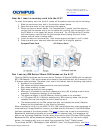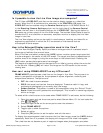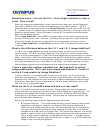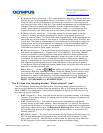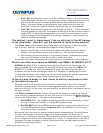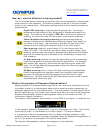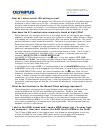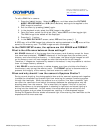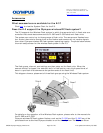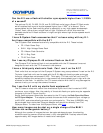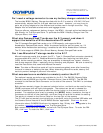
DIGITAL TECHNICAL SUPPORT
OLYMPUS IMAGING AMERICA INC.
(888) 553-4448
http://support.olympusamerica.com
©2008 Olympus Imaging America Inc. Page 13 of 26 Last updated on February 28, 2008
• A (Aperture Priority shooting) – This mode allows the aperture to be set manually,
thereby giving the photographer control over depth-of-field. This mode also uses
Program Shift, so the photographer can select any aperture in the range of the
lens using the main dial or sub dial. The camera compensates for the exposure by
changing the shutter speed automatically as the f-stops are changed. If the
shutter speed/aperture combination will result in under- or overexposure, the
exposure values in the viewfinder and on the Control Panel screen will blink.
• S (Shutter Priority shooting) – This mode allows the shutter speed to be set
manually, thereby giving the photographer control over stopping action or
reducing camera shake. This mode also uses Program Shift, so the photographer
can select any shutter speed in the range of the camera body using the main dial
or sub dial. The camera compensates for the exposure by changing the aperture
automatically as the shutter speeds are changed. If the shutter speed/aperture
combination will result in under- or overexposure, the exposure values in the
viewfinder and Control Panel screen will blink.
• M (Manual shooting) – This mode allows the photographer to set the shutter speed
and aperture independently. Program Shift is not applied in this mode. Manual
mode is invaluable to photographers using studio electronic flash systems and
manual hot shoe electronic flashes because it allows the user to set the correct
sync speed for flash and set an f-stop determined by a flash meter reading or
testing. It also allows for use in exotic photographic situations such as scientific
and engineering photography beyond the parameters of the camera firmware.
In the Manual shooting mode the shutter speed is set using the main dial and the
aperture is set using the sub dial.
Note: When [;] is set to
, two additional shooting modes are available:
Underwater Wide and Underwater Macro. Press the [Mode] button while turning
the main dial to select these shooting modes. To use the E-3 for underwater
photography, attach a commercially available underwater housing. While using
either underwater mode, the following functions are not available: CUSTOM
RESET, PICTURE MODE and MY MODE SETUP.
The E-3 has five focusing modes. Which should I use?
The five focusing modes are provided to offer the photographer greater flexibility in
setting up the camera for diverse shooting situations. Any of the focusing modes that
have an MF in their designation allow the photographer to adjust the focus by turning
the focusing ring on the lens.
• S-AF (Single AF) – Every time the shutter button is pressed halfway, the camera
focuses. This mode is suitable for taking pictures of still subjects or subjects with
limited movement.
• C-AF (Continuous AF) – The camera continuously refocuses as long as the
shutter button is held down halfway. When the subject is in motion, the camera
focuses on the subject in anticipation of its movement using Predictive Autofocus
technology. When shooting in the Sequential Shooting Drive mode, Continuous
AF resumes after a burst of images when the shutter button is returned to the
halfway position.
• MF (Manual Focus) – The lens is focused manually by rotating the lens focus ring.
Still life and landscape photographers may prefer this focus mode as it allows
more creative control. Manual Focus must be used for accurate focus when the
EC-25 Extension Tube is mounted between a lens and camera body.



